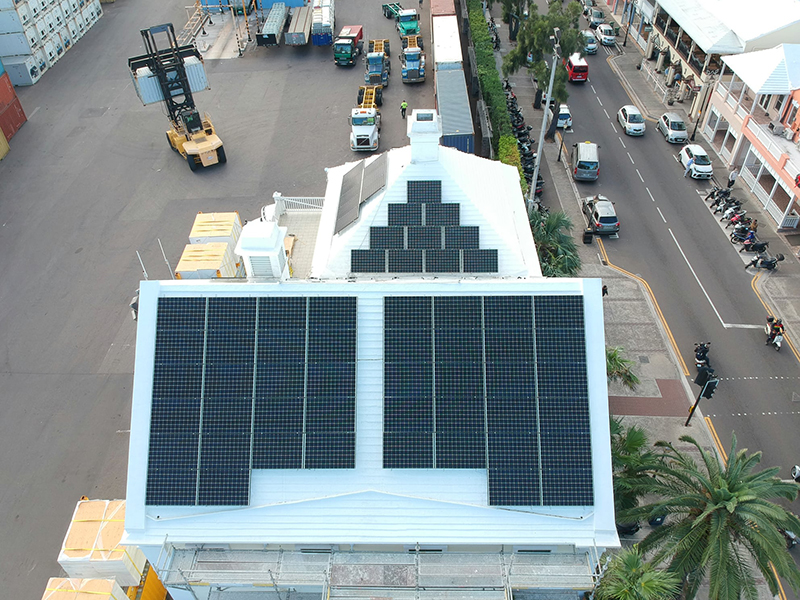78 Solar Panels Installed At City Pump Station
78 solar panels have been installed at the City of Hamilton’s Front Street pump station which is anticipated to “save the City more than $30,000 a year on electricity costs.”
A spokesperson said, “This month the City of Hamilton oversaw the installation of 78 solar panels at its Front Street pump station which, it is anticipated, will save the City more than $30,000 a year on electricity costs.
“The solar panels, installed by Bermuda Alternate Energy [BAE], will come online next month and will power the City’s Front Street pump station which carries Hamilton’s sewage [totaling about 500,000 – 600,000 gallons per day] to the Seabright outfall on South Shore.
“The energy needed for the pump station does more than just power the moving of sewage through the pipes; it also powers the screening machine, the sewage monitoring system, and the pump station’s communications hub.”
“The pump station runs 24/7,” explained Assistant City Engineer Charles Waters. “This is a huge electrical load in pumping energy. We spend more than a quarter of a million dollars each year on electricity costs for this pump station alone.
“The solar panels will really chew into the baseload amount and substantially lower our BELCO bills – by as much as ten per cent initially. We will start seeing a financial return as soon as the panels come online.”
A spokesperson noted, “The City already has a significant solar panel installation at its Works Depot and has plans for further installations on some of its other buildings including Pier 6 and Customs House. The energy generated from these solar projects would power those buildings as well as feed into the Front Street pump station – potentially lowering energy costs to the pump station by a further 25 per cent.
“Additionally, the City has plans to install solar carports on the fourth floor of Bull’s Head car park and the City Hall car park which will offset electricity costs at the Works Depot as well as City Hall.
“City technicians are also working hard from an efficiency perspective – carrying out interior renovations such as converting the City’s lighting network to LED and finding innovative ways to reduce HVAC costs. Following an extensive study of the City’s infrastructure, one of the greatest inefficiencies was found to be storm and ground water surreptitiously entering the sewage system.”
Mr. Waters explained: “Over the years we have had issues with freshwater and seawater entering our sewage system. This can happen if a manhole is not sealed properly, if there is an incorrect connection to the sewage line, or if there is a broken pipe.
“It costs the City a significant amount of money to pump all of the [non-sewage] water all the way over to South Shore. Some parts of the City sewage system are actually under the water table, so if a line breaks, it allows literally thousands of gallons of seawater into the system which we then have to pump across the island.”
Since the end of 2019, the City’s two wastewater technicians have video surveyed almost half of the City’s sewer line, looking for cracks and leaks.
“This allows us to identify any cracks, repair the system and patch the holes,” said Mr. Waters. “To fix the pipes, technicians feed an inflatable bladder through the pipes to the location of the crack which is wrapped in a silica -resin epoxy impregnated fiberglass.
“When we reach the location of the break, we inflate it and let the epoxy resin set. The new waterproof membrane stops the water from coming in and saves us from having to dig up the road at a large expense.”
The City added that they have “completed four major repairs so far which will save the City tens of thousands of dollars every year.”
Read More About
Category: All, Environment, News




Let’s hope the two techs found whatever leak makes that stretch of Front Street have such a godawful stench.
We must STOP pumping our City sewage into the ocean!!! That’s just not acceptable when other options exist!!!